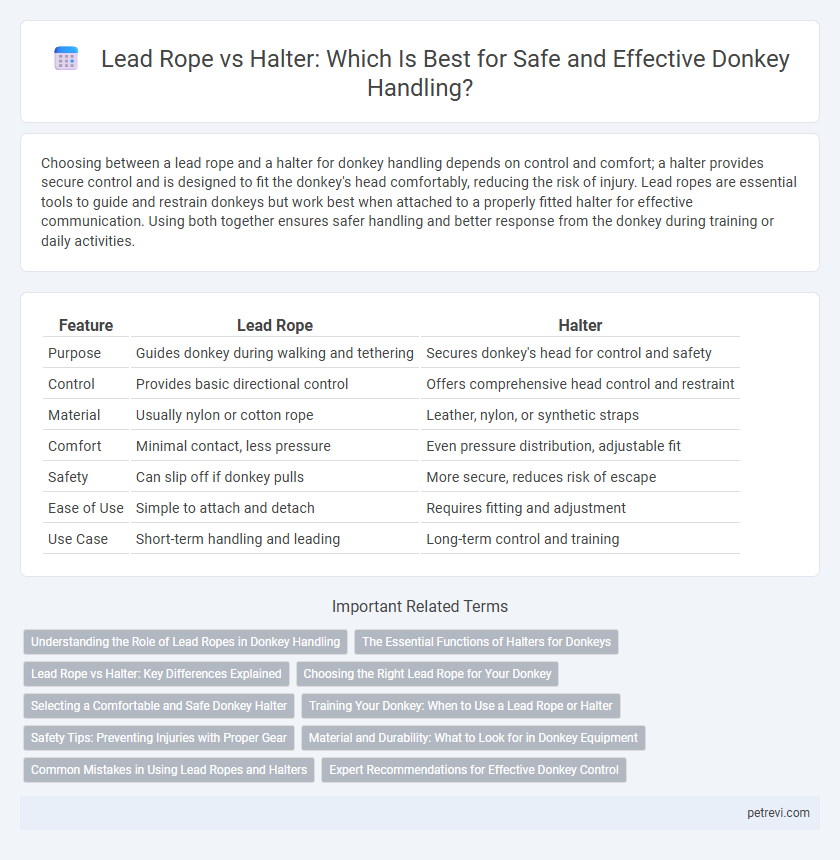Choosing between a lead rope and a halter for donkey handling depends on control and comfort; a halter provides secure control and is designed to fit the donkey's head comfortably, reducing the risk of injury. Lead ropes are essential tools to guide and restrain donkeys but work best when attached to a properly fitted halter for effective communication. Using both together ensures safer handling and better response from the donkey during training or daily activities.
Table of Comparison
| Feature | Lead Rope | Halter |
|---|---|---|
| Purpose | Guides donkey during walking and tethering | Secures donkey's head for control and safety |
| Control | Provides basic directional control | Offers comprehensive head control and restraint |
| Material | Usually nylon or cotton rope | Leather, nylon, or synthetic straps |
| Comfort | Minimal contact, less pressure | Even pressure distribution, adjustable fit |
| Safety | Can slip off if donkey pulls | More secure, reduces risk of escape |
| Ease of Use | Simple to attach and detach | Requires fitting and adjustment |
| Use Case | Short-term handling and leading | Long-term control and training |
Understanding the Role of Lead Ropes in Donkey Handling
Lead ropes play a crucial role in donkey handling by providing control and guidance when leading or securing the animal. Unlike halters, which fit around the donkey's head, lead ropes attach to the halter to allow handlers to manage the donkey's movements safely and effectively. Proper use of a lead rope enhances communication between the handler and donkey, promoting calm, cooperative behavior during activities such as walking, training, or veterinary care.
The Essential Functions of Halters for Donkeys
Halter for donkey handling is essential for control, safety, and communication, providing a secure fit around the head and enabling effective attachment of a lead rope without causing discomfort. Unlike lead ropes, halters distribute pressure evenly across the donkey's head, reducing the risk of injury during guidance or restraint. Properly fitted halters are crucial for everyday tasks such as grooming, veterinary care, and training, ensuring humane and efficient handling.
Lead Rope vs Halter: Key Differences Explained
A lead rope is a simple, flexible line attached to a donkey's halter primarily used for guiding and controlling movement, whereas a halter is a headgear that fits around the donkey's head providing attachment points for the lead rope. The lead rope offers direct control during walking or tying, while the halter ensures secure fit and pressure distribution to prevent injury or escape. Understanding these differences optimizes donkey handling by combining the halter's security with the lead rope's maneuverability.
Choosing the Right Lead Rope for Your Donkey
Selecting the right lead rope for your donkey involves prioritizing durability and comfort, with materials like nylon or cotton being popular for their strength and softness. A rope length of 6 to 8 feet provides optimal control and safety during handling, ensuring ease of movement without compromising security. Consider a rope with a secure, easy-to-use snap or buckle attachment to the halter for effective management and quick release in emergencies.
Selecting a Comfortable and Safe Donkey Halter
Choosing a comfortable and safe donkey halter involves prioritizing materials like soft nylon or leather that reduce rubbing and irritation on the donkey's sensitive skin. Proper fit is essential, ensuring the halter sits snugly without causing pressure points, with adjustable straps to accommodate the donkey's head shape. Compared to lead ropes, halters provide more control and safety during handling, making them a crucial tool for effective donkey management.
Training Your Donkey: When to Use a Lead Rope or Halter
Using a halter is essential during initial donkey training for control and guidance, especially when teaching basic commands and leading techniques. A lead rope attached to the halter offers flexibility and safety by allowing distance control while walking or tying the donkey. Transitioning between halter and lead rope use depends on the donkey's training progress and temperament to ensure effective handling and secure management.
Safety Tips: Preventing Injuries with Proper Gear
Using a lead rope combined with a well-fitted halter significantly enhances donkey handling safety by providing better control and reducing the risk of sudden movements that cause injuries. Select halters made from durable, soft materials to prevent chafing and skin abrasion, ensuring comfort during extended wear. Always inspect lead ropes for wear and secure knots properly to maintain reliable grip and prevent accidental escapes or entanglement hazards.
Material and Durability: What to Look for in Donkey Equipment
When selecting donkey handling equipment, prioritize lead ropes made from high-strength materials such as nylon or polyester, which offer excellent durability and resistance to fraying. Halters constructed from reinforced leather or heavy-duty synthetic fibers provide long-lasting wear and secure fit, essential for managing the strength of donkeys. Look for equipment with strong metal hardware like brass or stainless steel to ensure safety and durability under regular use.
Common Mistakes in Using Lead Ropes and Halters
Common mistakes in using lead ropes and halters for donkey handling include improper fit, which can cause discomfort or injury, and incorrect knotting that compromises control. Many handlers underestimate the importance of regularly checking for wear and tear on lead ropes, increasing the risk of breakage during use. Using halters that are too tight or too loose often leads to stress and behavioral issues in donkeys, emphasizing the need for proper adjustment tailored to donkey anatomy.
Expert Recommendations for Effective Donkey Control
Experts recommend using a lead rope combined with a well-fitted halter for optimal donkey control, ensuring safety and comfort for both handler and animal. A halter designed specifically for donkeys distributes pressure evenly across the head, preventing injury and making the animal more responsive. High-quality, durable lead ropes with a secure snap hook improve handling by offering reliable grip and reducing the risk of accidental release during training or transport.
Lead Rope vs Halter for Donkey Handling Infographic

 petrevi.com
petrevi.com